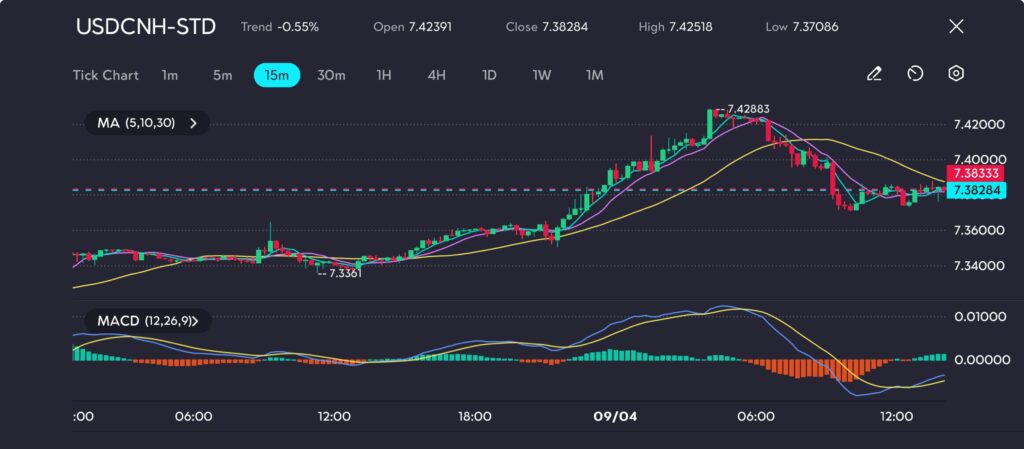
The yuan is back in the spotlight as fresh US–China trade tensions rattle markets and raise questions about Beijing’s next move. With pressure mounting on China’s currency, investors are weighing the risk of further declines and watching closely for signs of official intervention. Here’s what the latest shift means for the offshore yuan and broader market sentiment.
The offshore Chinese yuan (USDCNH) fell to a record low of 7.4288 against the US dollar on 9 April, as intensifying trade tensions between the US and China heightened investor uncertainty.
The currency later recovered slightly during the Asian trading session, climbing 0.62% to 7.3833.
This notable depreciation followed the United States’ announcement of a 104% tariff on Chinese imports, prompting concerns over the yuan’s stability and the broader consequences of the growing trade dispute.
In response to the rapid decline, Chinese state-owned banks intervened by selling US dollars in the forex market to slow the yuan’s fall.
Simultaneously, the People’s Bank of China (PBoC) set the onshore yuan’s (USDCNY) midpoint at 7.2066—its weakest level since September 2023.
The PBoC remains active in managing the yuan’s trajectory. Although a weaker yuan can enhance export competitiveness, sustained depreciation may result in capital outflows and undermine financial market stability, making intervention necessary.
The USDCNH pair declined by 0.55%, ending the session at 7.3828 after peaking at 7.4288. While the pair opened higher, it reversed gains as selling pressure intensified.

From a technical standpoint, the moving averages (5, 10, and 30) point to a bearish trend, with shorter-term averages crossing below longer-term ones.
The MACD indicator (12, 26, 9) also confirms this sentiment, displaying a negative histogram and a MACD line positioned beneath the signal line.
The key technical levels to monitor are resistance at 7.4288 and support at 7.3361. A break below support may suggest further downside, while a move above resistance could signal the start of a rebound.
As the US–China trade dispute drags on with no clear resolution in sight, the offshore yuan is expected to remain under pressure. The intensifying rhetoric and policy moves from both sides have amplified market uncertainty, prompting traders to adopt a more cautious stance.
While a weaker yuan could offer short-term support to China’s export sector, prolonged depreciation risks triggering capital outflows and undermining investor confidence.
Going forward, the direction of the yuan will likely hinge on the outcome of trade negotiations, any escalation in tariffs, and the extent of intervention from the People’s Bank of China (PBoC).
Market participants will also be watching global risk sentiment, economic data from China and the US, and signals from central banks. In the absence of a diplomatic breakthrough, currency volatility is likely to remain elevated, leaving the yuan exposed to further swings in the near term.
Click here to open account and start trading.